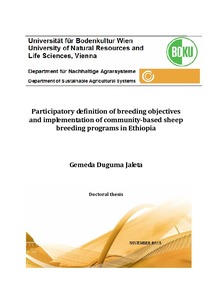Participatory definition of breeding objectives and implementation of community based sheep breeding programs in Ethiopia
Abstract
The objectives of this study were participatory definition of sheep breeding traits of smallholder farmers/pastoralists and implementation of community-based sheep breeding programs in different production systems in Ethiopia. Four study areas: Afar (pastoral), Bonga and Horro (crop-livestock), and Menz (sheep-barley) were considered. Choice experiments were employed to define traits preferences in the different production systems. The approach was found to be important to value both tangible and intangible traits; the latter would have been concealed when one uses conventional valuation methods. Traits preferences of the communities were heterogeneous except for body size in rams and mothering ability in ewes. Three measureable traits that were most preferred by the respective communities were selected as objective traits and used for simulation of alternative breeding schemes. The alternative schemes were presented to communities and jointly discussed upon with scientists focusing on the advantages and disadvantages of the different scenarios. Equipped, with this information, the community members finally made a decision as to which scheme(s) they liked and therefore want to implement. Prior to implementation, baseline information was collected for benchmarking and evaluation of the changes that will be realized from the improvement intervention. A total of 1364 in Afar, 1074 in Bonga, 2248 in Horro and 2411 in Menz sheep were ear-tagged. Recording formats were developed and enumerators were employed for communities to assist households in the measurements and recording. Monitoring of the breeding activities was done fortnightly by a research team from respective research center. Two stages of selection were applied to select breeding rams: initial screening at 6- and final selection at 12 months of age. A committee composed of 5 members from each community was actively involved in the selection process. A total of 14, 21, 36, and 50 rams have been selected and distributed for use in Afar, Bonga, Horro admen, respectively in two rounds of selection. Seed money was provided by the project to purchase the selected rams for the community and different ram-groups were formed based on number of breeding ewes, settlement and communal grazing areas.

